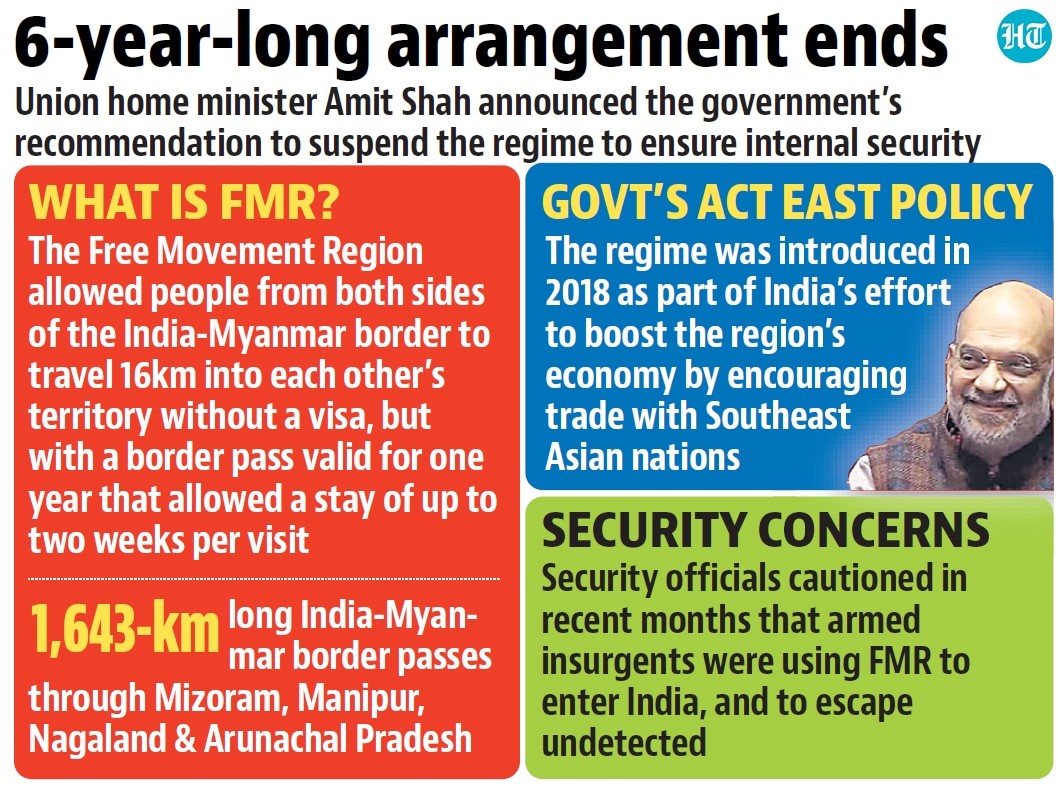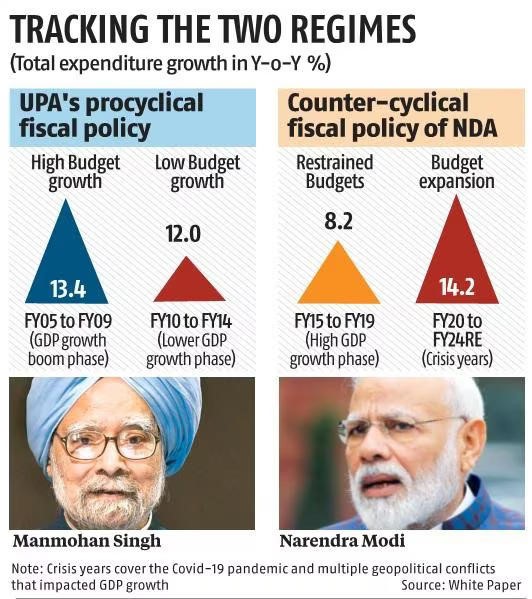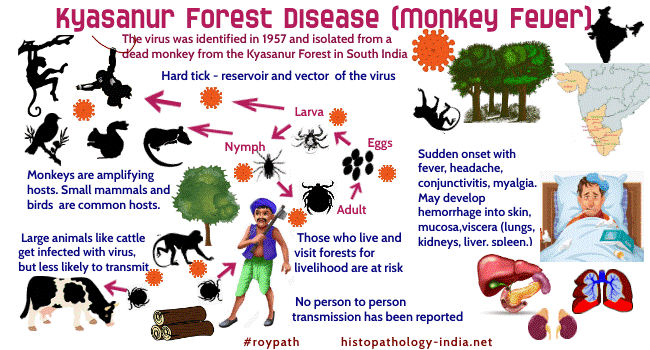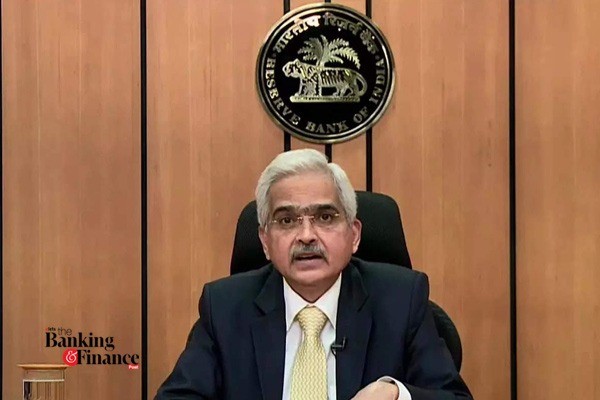1. India has decided to temporarily halt the Free Movement Regime (FMR) with Myanmar.
Introduction
The decision to abolish the Free Movement Regime (FMR) along the India-Myanmar border, as declared by the Union Home Minister, marks a significant policy shift with far-reaching implications.
About Free Movement Regime
- Implemented in the 1970s, the FMR permitted individuals residing within 16 kilometers of the India-Myanmar border to traverse up to 16 kilometers into the neighboring country without the requirement of a visa.
- This initiative acknowledged the deep-seated familial and ethnic ties between communities residing on both sides of the unfenced border.
- India shares a 1,643-kilometer border with Myanmar, spanning across the states of Arunachal Pradesh (520 km), Nagaland (215 km), Manipur (398 km), and Mizoram (510 km).
- Despite its initial inception decades ago, the FMR underwent its most recent revision in 2016 to align with India’s Act East policy.
- However, its implementation in Manipur was halted in 2020 due to the COVID-19 pandemic.
Historical Context of India-Myanmar Relations
The bilateral relations between India and Myanmar have been shaped by a complex interplay of historical events and geopolitical dynamics:
- Pre-1937: An era characterized by profound cultural and religious exchanges, notably within the framework of ancient Buddhist interactions.
- 1937 Separation: The separation of Burma from British India resulted in distinct political trajectories for the two nations.
- Post-1962 Coup: Tensions arose due to Myanmar’s military rule and its alignment with China, leading to strains in relations with India.
- 1990s Shift: India initiated a renewed engagement with Myanmar under its Look East Policy, emphasizing economic and strategic cooperation.
- 2015 Democracy: The transition to democracy in Myanmar marked a positive turn in bilateral relations.
- 2021 Coup: The recent military coup in Myanmar has posed fresh challenges, impacting the stability of the region and bilateral relations.
Significance of Myanmar to India
- Border Connectivity: The extensive land border of over 1600 km and maritime boundary in the Bay of Bengal underscore the importance of stability in Myanmar for India.
- Strategic Location: Myanmar’s geostrategic position is crucial for India’s Act East policy and the development of the Northeast region, serving as a vital conduit between South Asia and Southeast Asia.
- Multilateral Engagement: Myanmar’s participation in regional forums such as BIMSTEC and its observer status in SAARC enhance India’s multilateral engagement in the region.
- Security Concerns: Myanmar’s territory harbors insurgent groups like NSCN-K and poses challenges related to counter-insurgency efforts and combating the drug trade.
- Mitigating Chinese Influence: Strengthening ties with Myanmar serves as a strategic counterbalance to China’s expanding influence in the region.
From a socioeconomic perspective:
- Cultural Bonds: India and Myanmar share deep-rooted cultural, religious, and linguistic affinities, fostering strong cultural ties.
- Indian Diaspora: The sizable Indian-origin population in Myanmar contributes to people-to-people interactions between the two nations.
- Infrastructure Development: Projects such as the Kaladan Multi-Modal Transit Transport Project and the Sittwe Port aim to bolster connectivity, trade, and investment.
- Trade Relations: India stands as one of Myanmar’s top trading partners, with bilateral trade reaching USD 1.03 billion in 2021-22.
- Energy Security: Myanmar plays a crucial role in India’s energy security, with significant investments in the oil and gas sector.
Reasons for Policy Shift
- Combatting Drug Trafficking and Insurgency: Myanmar’s role as an opium producer fuels drug trafficking and supports insurgent activities in India’s northeastern states.
- Refugee Influx: The aftermath of the military coup in Myanmar has led to a surge in refugee arrivals in states like Mizoram and Manipur, raising security concerns.
- Local Government Advocacy: Manipur’s Chief Minister has advocated for the cancellation of the FMR and emphasized the need for border fencing, citing concerns over ethnic violence linked to unrestricted cross-border movement.
The Way Forward
- Border Security Measures: The government intends to initiate border fencing along approximately 300 km, with tendering processes expected to commence soon.
- Policy Refinements: Experts suggest revising the FMR to strike a balance between regulating movement and preserving cross-border ties effectively.
- Infrastructure Development and Trade Formalization: Improving infrastructure and formalizing trade at designated entry points could help mitigate adverse impacts.
Community Participation: Involving border communities in decision-making processes is paramount for ensuring effective and inclusive border management strategies.
2. The White Paper on Economy: Its Political Implications
Introduction:
- The recent unveiling of a comprehensive analysis titled a “white paper” on the Indian economy by the Finance Minister in Parliament has sparked extensive debates surrounding the economic trajectory of the nation over the preceding two decades.
- This document, meticulously crafted by the Ministry of Finance, offers an insightful comparative examination of economic governance under both the Congress-led UPA governments and the BJP-led NDA governments.
Objectives of the White Paper:
The white paper on the Indian economy delineates four primary objectives:
- Informing Governance Challenges:
- Its foremost aim is to elucidate the economic and fiscal challenges inherited by the NDA government from its predecessor, the UPA administration.
- For instance, statistical data demonstrates a significant escalation in the fiscal deficit during the UPA era, soaring from 2.5% in 2004-05 to 6.5% in 2013-14.
- Highlighting Policy Interventions:
- Another objective is to highlight the policies and measures undertaken by the NDA government to counter economic challenges and reinstate fiscal stability.
- Notably, the white paper underscores the implementation of transformative reforms such as the Goods and Services Tax (GST) and the Insolvency and Bankruptcy Code (IBC), which have played pivotal roles in restoring economic equilibrium.
- Fostering Informed Debate:
- By furnishing a comprehensive analysis, the white paper endeavors to stimulate broader and more enlightened discussions on matters of national importance and fiscal prudence.
- It offers detailed insights into the ramifications of corruption scandals during the UPA regime on economic governance and public trust.
- Emphasizing National Development:
- Echoing the sentiments of Prime Minister Narendra Modi, the document accentuates the imperative of committing to national development, advocating for a renewed focus on growth, innovation, and inclusive development.
- It highlights the significance of fiscal responsibility and efficient governance in attaining sustainable economic growth.
Contents and Claims:
- Pre-2014 Economic Condition:
- The period preceding 2014 was characterized by a fragile economic landscape, marked by mismanagement, financial indiscipline, and widespread corruption.
- The economy grappled with significant challenges, including the ‘twin balance sheet problem,’ exacerbating the inability of companies and the banking sector to invest, extend credit, and generate employment.
- Furthermore, double-digit inflation, coupled with burgeoning fiscal and revenue deficits, compounded the economic distress faced by ordinary households.
- Additionally, a dearth of decisive policymaking and inadequate investment in infrastructure further tarnished India’s business climate and global standing.
- Rampant corruption scandals inflicted colossal revenue losses on the exchequer, eroding investor confidence and stalling economic growth.
- Post-2014 Economic Reforms and Achievements:
- Conversely, post-2014 witnessed a series of economic reforms aimed at stabilizing the economy and fostering growth.
- These measures facilitated the transition from a ‘twin balance sheet problem’ to a ‘twin balance sheet advantage,’ significantly curbed inflation, and bolstered foreign exchange reserves.
- Furthermore, concerted efforts were directed towards infrastructure development and digitalization, culminating in the expedited rollout of 5G in 2023 and widespread 4G coverage.
- The implementation of transparent governance measures, including objective auctions for natural resources, bolstered both the economy and public finances, restoring investor confidence and elevating India’s global stature.
Major Interventions: NDA’s Gamechanger:
Transformative Governance Reforms:
Under the NDA regime, transformative governance reforms, such as spearheading a digital revolution to enhance transparency and streamline governance processes, alongside fostering participatory governance through citizen engagement in policymaking, have been instrumental in promoting inclusive development.
Social Welfare Schemes:
The NDA government introduced a plethora of social welfare schemes aimed at inclusive growth and poverty alleviation. These initiatives encompass a wide array of sectors, ranging from financial inclusion through the Jan Dhan Yojana to healthcare access via the Ayushman Bharat-Pradhan Mantri Jan Arogya Yojana.
Critical Analysis:
- While the white paper offers valuable insights into India’s economic trajectory, critics have raised concerns regarding its selective emphasis and lack of comprehensive analysis.
- Some argue that a holistic assessment of the economy necessitates a nuanced understanding of various factors, including social indicators and long-term structural reforms.
- Additionally, key issues such as unemployment and poverty alleviation are conspicuously absent from the analysis, prompting questions about the document’s comprehensiveness.
Conclusion:
The unveiling of the white paper on the Indian economy underscores the government’s commitment to transparency and accountability. However, its selective focus and limited scope warrant cautious interpretation.
Moving forward, a more inclusive and evidence-based approach to economic analysis is imperative to inform policy decisions and foster sustainable development in India.
3. Challenges Surrounding Self-Disclosure of Mental Health Conditions
https://www.thehindu.com/sci-tech/health/self-reporting-of-mental-disorders-in-india-lower-than-actual-burden-study/article67822356.ece
Introduction:
Recent studies, such as one conducted by researchers affiliated with IIT Jodhpur, have highlighted a concerning trend of underreporting mental health issues in India.
Mental Health Under-Reporting in India:
- Findings from the NSS 2017-2018 survey, which encompassed over 550,000 respondents, revealed startlingly low rates of self-reported mental illness, standing at less than 1%.
- The scale of mental illness in India is staggering, with the 2017 NMHS conducted by NIMHANS estimating approximately 150 million individuals in need of mental health treatment.
- According to WHO estimates, India bears a significant burden with 2443 DALYs per 10,000 population and an age-adjusted suicide rate of 21.1 per 100,000.
- India’s contribution to global suicide deaths escalated to 36% in 2016, with a troubling uptick observed in 2021, particularly among youth and middle-aged adults.
- The National Mental Health Survey underscores alarming rates of depression among teenagers and a prevalence of Substance Use Disorders (SUDs) at 22.4% among adults, emphasizing the severity of the issue.
Key Challenges:
- Social stigma and inadequate awareness hinder access to mental healthcare, leading to delayed treatment-seeking behavior and social isolation.
- A study conducted at IIT Jodhpur revealed substantial out-of-pocket expenses, especially within the private sector, for mental health services.
- Individuals with lower income and education levels are more susceptible to mental disorders, exacerbating their socioeconomic struggles.
- There exists a socioeconomic disparity, as individuals with higher incomes are more likely to report health problems.
Government Initiatives:
- The Mental Healthcare Act of 2016 aims to protect the rights of individuals with mental illnesses, improve access to mental healthcare, and decriminalize suicide attempts.
- The National Mental Health Policy of 2014 prioritizes universal access to mental healthcare and seeks to address risk factors associated with mental health issues.
Way Forward:
- Launch nationwide campaigns to combat stigma surrounding mental illness.
- Integrate mental health education into educational curricula and provide resources in local languages to enhance awareness.
- Strengthen collaboration between central and state governments for effective policy implementation.
- Explore tele-mental health services, support NGOs, and engage communities to address resource shortages.
- Adopt a multisectoral approach to mental health promotion and enforce legal frameworks.
- Establish quality metrics, recognize mental health advocates, and ensure affordability and accessibility of care.
- Explore traditional healing practices such as Yoga and Ayurveda alongside modern interventions.
Conclusion:
By prioritizing mental healthcare and fostering collaboration across sectors, India can establish a robust mental health ecosystem that promotes well-being and supports those in need. Embracing both traditional healing practices and modern interventions can offer comprehensive solutions, leading to a mentally healthier nation.
4. Kyasanur Forest Disease (KFD): A Persistent Concern
Introduction
The recent surge in fatalities attributed to Kyasanur Forest Disease (KFD), commonly referred to as monkey fever, within Karnataka, has ignited significant concerns regarding the potential escalation of this viral ailment.
Understanding Kyasanur Forest Disease (KFD)
- Historical Background and Identification: KFD is caused by the Kyasanur Forest disease virus (KFDV), classified within the Flaviviridae virus family.
- Its discovery traces back to 1957 when it was initially identified within the confines of Karnataka’s Kyasanur Forest.
- Incidence and Mortality Rates: Annually, an approximate of 400 to 500 human cases are documented, with mortality rates ranging from 3% to 5%.
Transmission Dynamics
- Tick-Borne Transmission: Human infection with KFD primarily occurs through tick bites or contact with infected animals, particularly ailing or deceased monkeys.
- Minor Role of Animals: Although larger animals like goats, cows, and sheep can contract the disease, their contribution to disease transmission remains minimal. Moreover, there is no substantiated evidence suggesting transmission through unpasteurized milk.
Manifestations and Symptoms
- Initial Symptoms: The disease typically initiates with symptoms such as chills, fever, and headache following an incubation period of 3-8 days.
- Progression: Within 3-4 days, patients may experience severe muscle pain, vomiting, gastrointestinal complications, and a propensity for bleeding. Some individuals may develop neurological symptoms during the third week, including intense headaches and visual impairments.
Diagnostic Techniques and Treatment
- Diagnostic Procedures: Early detection methods involve molecular identification through PCR or virus isolation from blood samples. Subsequent serologic testing via ELISA is conducted for confirmation.
- Therapeutic Approach: Although specific treatment modalities are lacking, timely hospitalization coupled with supportive therapy, notably hydration management, remains pivotal.
Preventive Measures
- Vaccination: To mitigate the prevalence of KFD, vaccination is administered within endemic regions of India as a preventive measure.
Adoption of Preventive Measures: The use of insect repellents and wearing protective clothing is strongly advocated in tick-infested areas to mitigate the likelihood of infection.
5. Key Insights from the Reserve Bank of India's Monetary Policy Committee Meeting
Context:
In the recent development concerning the Reserve Bank of India’s Monetary Policy Committee (MPC), the committee, in its sixth meeting, has opted to maintain the status quo on the repo rate. Additionally, a notable decision has been made to extend the Key Fact Statement (KFS) requirements to encompass all retail and MSME loans.
Key points from the meeting include:
- The decision to maintain the policy repo rate at 5% has been upheld by the Reserve Bank of India’s Monetary Policy Committee.
- Projections indicate that the Consumer Price Index (CPI) for FY24 is expected to stand at 5.4%, while it is anticipated to decrease to 4.5% in FY25. Furthermore, the RBI has set the real GDP growth for FY25 at 7%.
- Forecasts suggest that retail inflation will average at 5.4% for this fiscal year and is projected to decline to 4.5% in FY25.
- The issue of incomplete monetary transmission by financial institutions remains pertinent.
- It is anticipated that the current economic momentum will persist into the next fiscal year.
- The RBI intends to introduce an offline functionality in CBDC-Retail to facilitate transactions in areas with poor or limited internet connectivity.
- Regulatory framework review for electronic trading platforms is on the agenda to grant market makers access to offshore ETPs offering permitted Indian Rupee products.
- Lenders have been directed by the RBI to furnish key fact statements (KFS) regarding loan agreements, including all-inclusive interest costs, to borrowers for both retail and MSME loans.
Key Fact Statement (KFS)
- The Key Fact Statement (KFS) serves as a concise document offering borrowers essential information about their loan agreements, including the actual annualized interest rate, encompassing base interest as well as any additional charges, fees, and penalties.
- Notably, the extension of KFS requirements to cover all retail and MSME loans underscores the importance of transparency and empowerment for borrowers.
- In essence, monetary policy pertains to the central bank’s policy regarding the utilization of monetary instruments to achieve specified goals. The amended RBI Act, 1934, outlines provisions for setting inflation targets, aiming for transparency and accountability, as proposed by the Urjit Patel Committee.








